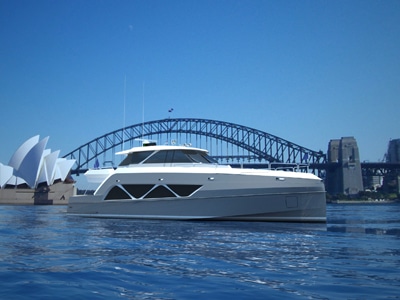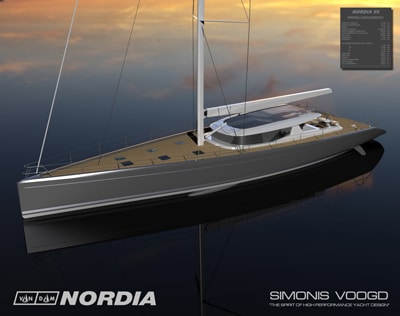
Hyundai Yachts ASAN 62 Motoryacht
Hyundai Yachts wanted an ultracontemporary design for its ASAN line — one that would also offer yachtsmen maximal, and useful, interior volume. As often happens in yacht design, Bill Prince turned to the past, and to a workboat, for inspiration in solving the competing requirements.
Designers of modern motoryachts almost universally rely on sleek compound curves and dramatic sweeps to achieve a contemporary look. This trend coincides with automotive designers’ quest for attractive exteriors combined with efficient aerodynamics, both of which compromise space within the cabin. What to do if you want a large interior? Make the cars larger or make them look like a London taxi or a Nissan Cube.
The same principle applies to boats of all sizes. If you want the largest possible interior on a given length and beam, put a box on a barge. If you want it to look very cool and ultramodern, you could adapt the basic design criteria from a Great Lakes commercial gill-net boat, as Prince has done. (You can get a good look at these boats by going to www.flickr.com and typing “gill-net boats great lakes” in the search box.) These boats look the way they do — wall sides, flush deck and centered pilothouse — to give the fisherman a massive hold for his catch.
Prince’s approach is definitely “outside the box,” but the result is exactly what the client requested. The interior of the ASAN 62 has three staterooms and three heads, a full-beam lounge area amidships and a galley/dinette all the way aft. Prince said that this 62-footer has as much volume belowdecks as you’ll find in a typical yacht of 75 to 80 feet. The pilothouse has an L-shape settee, a head and a staircase that leads to the galley and spaces belowdecks.
Wrapping all this volume in an alluring package required a certain level of free association. Plumb ends anchor this design and provide it with a waterline length that nearly equals the overall length. What’s more, Prince likes the look of plumb stems, but to reduce the abruptness of the purely vertical, he’s drawn tumblehome in the transom and at the bow where the stem engages the superstructure. That’s right — superstructure. The sheer line of the ASAN 62’s hull is really at the rub rail. Slicing away everything above that line leaves a perfectly fine hull on which Prince can draw any number of new designs. The same concept gives commercial gill-net boats their astonishing aesthetic variety.
The superstructure grows from the stem at an angle that also appears in the rake of the windshield and in the engineering truss. Then it flattens and continues to rise as you follow it aft, creating a wedge. This wedgelike shape gives the ASAN an aggressive look, maybe warning observers that they’ve met a fast and seaworthy yacht. It also visually reduces the yacht’s imposing height, as does beveling the top of the structure along its entire length. Scuppers indicate the level of the side decks, which are very wide, but because they are above the accommodations, they don’t encroach on the space below. High bulwarks add to the safety of anyone who goes forward while the boat is under way.
Prince also used the bevel to good effect on the sun deck off the pilothouse, where it unifies the design visually and makes that part of the structure seem almost delicate. The truss in the side window of the pilothouse, identical in shape and angle to the one below, establishes the relationship between the house and the structure below it.
Kudos to Prince and Hyundai Yachts for having the courage and creative ability to bring yachtsmen something truly new and different.
Bill Prince Yacht Design, (727) 403-1611; www.billprinceyachtdesign.com; Hyundai Yachts, www.hdyachts.com

Nordia 95
Compared with the fluid shapes that characterize so many modern sailing yachts, the Nordia 95, in the two-dimensional state we see here, seems almost Cubist. Pablo Picasso, Georges Braque and other Cubists shattered naturalistic forms and space in the early 1900s — the surfaces of their paintings intersecting at seemingly random angles as they tried to represent all aspects of three-dimensional reality on the flat canvas. Though often defying interpretation, these paintings nonetheless maintain harmony, albeit on the tense side.
In the spirit of Cubism, some of the lines Simonis Voogd used to create the deckhouse appear to be arguing with one another. The coachroof sits at a rakish angle, like a sportsman’s cap as he guides his 1939 Jaguar SS100 roadster along a country lane. The forward edge of the triangular sail panel that anchors the house breaks at an obtuse angle, seeming to urge the structure forward. Although the designer’s choice may seem random, careful study reveals that the slope of the coachroof closely matches that of the sail panel as it descends forward to the deck. A straightedge placed along the underside of the coachroof’s extension shows that if you continue that line to the deck, it intersects the base of the front windows. This is a subtle and artistic way to reinforce the yacht’s forward-looking stance.
Small details, which we may not see right away, often add interest to a design. Quoting the shape of certain minor elements at various locations throughout the design unifies the whole. I think this is especially true of classically styled yachts, the soft angles and sweeping curves of which comfort our senses. Simonis Voogd, too, has employed details to create harmony — to ease the observer’s first impression of dissonance. The triangular shape of the sail panel on the house appears again in the bow pulpit. Another triangular shape — lopped off at the top like the others — forms the safety rail at the transom. It’s more of a paraphrase than a quote, but in it, the designers have picked up the slope of the cockpit coaming abaft the twin helms and the trailing edge of the coachroof’s extension.
In keeping with the aggressive, edgy look of the Nordia 95, the design team has given it a straight sheer line, a straight and nearly plumb stem and a very short counter aft. I love a plumb stem — I suppose because of my affection for the New Haven (Connecticut) sharpies and sandbaggers of the 19th century and the modern, hyperperformance, offshore, multihull and monohull racing yachts. In all these examples, the plumb stem means business. Although this one is just a hair less than plumb, it still makes the appropriate statement.
Notwithstanding her aggressive appearance, the Nordia 95 is meant for cruising. Her lifting keel gives the owners access to most harbors and anchorages; her large social cockpit, forward of the business end and sheltered by a sliding tinted-glass panel, invites guests to enjoy one another’s company while the yacht is under way; and her tender garage in the transom encourages forays ashore.
On the other hand, the 95 is not cuddly, as are yachts of the classical genre, but the tension in her straight lines and sharp corners is precisely why she will excite and lure buyers and devotees. Few yachtsmen will be able to ignore her edgy presence, especially as she sails to a fresh breeze, her fine entry making light work of the seas and her shallow underbody trailing a flat wake.
Van Dam Nordia Shipyard, 011-31-297-324517; www.nordia.com
Simonis Voogd, 011-31-228-321900; www.simonis.com








